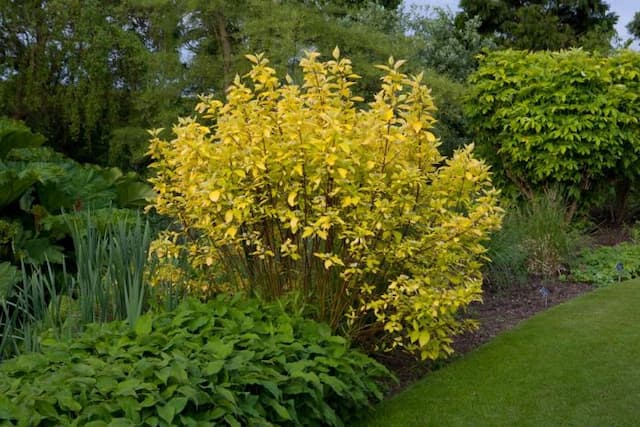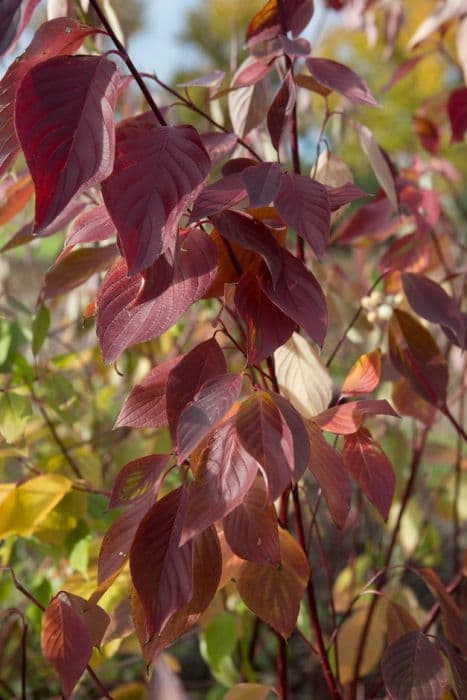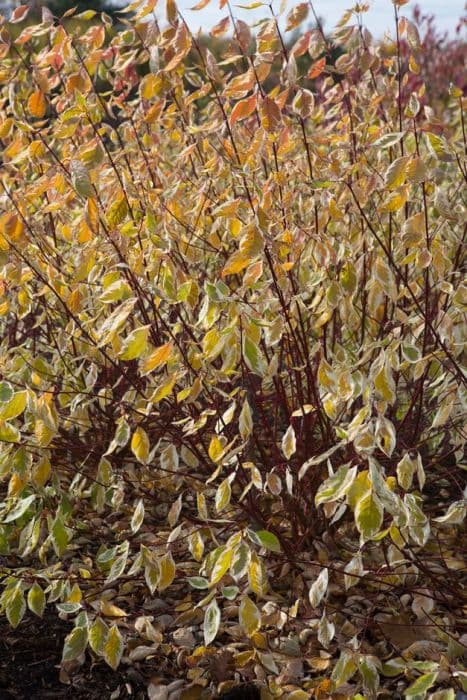Yellow Twig Dogwood Cornus sericea 'Flaviramea'

ABOUT
The Cornus sericea 'Flaviramea', commonly known as the Yellow Twig Dogwood, is best known for its striking stem color. In the winter landscape, this deciduous shrub stands out with its bright yellow-green twigs that provide a splash of color during the duller months. As the leaves fall, this feature becomes more pronounced and is often used for decorative purposes in gardens. The leaves of the Yellow Twig Dogwood are oval to lance-shaped with a pointed tip and are arranged in opposite pairs along the stems. In the growing season, they exhibit a green hue which transitions to variable shades of red and purple before falling off in autumn. This changing foliage adds another layer of interest throughout the seasons. Springtime brings small white flowers clustered in flat-topped bunches, which are then followed by white to pale blue fruit. This fruit is not only visually appealing but also attracts a variety of birds to the garden. The bark of the plant is smooth with a reddish-brown color on the older wood, contrasting with the younger yellow-green branches. In terms of its general shape, the Yellow Twig Dogwood typically forms an open, spreading habit with numerous branches creating a dense thicket. This attribute makes it an excellent choice for mass plantings or as a vibrant natural barrier. Its hardiness and adaptability to various conditions make it a resilient choice for gardeners looking to add year-round interest to their landscapes. The Yellow Twig Dogwood's appearance evolves with the seasons, providing a dynamic element to any garden setting.
About this plant
 Names
NamesFamily
Cornaceae
Synonyms
Yellowtwig Dogwood, Golden-Twig Dogwood, Yellow-Stemmed Dogwood
Common names
Cornus stolonifera 'Flaviramea', Swida sericea 'Flaviramea'.
 Toxicity
ToxicityTo humans
Cornus sericea 'Flaviramea', commonly known as Red Osier Dogwood, is not highly toxic to humans. However, as with many plants, caution is advised because different people can have varying sensitivities. The consumption of any part of the plant could potentially cause minor symptoms such as stomach upset, nausea, or vomiting in some individuals, but it is not known for causing severe poisoning.
To pets
The Red Osier Dogwood, as Cornus sericea 'Flaviramea' is commonly called, is not known to be highly toxic to pets. However, dogs, cats, and other animals can experience different levels of sensitivity to plants. Ingesting parts of this plant might cause mild gastrointestinal upset in some pets, which could lead to symptoms such as vomiting or diarrhea. Generally, severe toxicity is unlikely, but pet owners should still prevent their animals from eating ornamental plants.
 Characteristics
CharacteristicsLife cycle
Perennials
Foliage type
Deciduous
Color of leaves
Green
Flower color
White
Height
6-9 feet (1.8-2.7 meters)
Spread
6-9 feet (1.8-2.7 meters)
Plant type
Shrub
Hardiness zones
2-9
Native area
North America
Benefits
 General Benefits
General Benefits- Ornamental Appeal: Cornus sericea 'Flaviramea', commonly known as Yellow Twig Dogwood, offers striking yellow-green stems that provide visual interest in winter landscapes.
- Wildlife Habitat: It provides shelter and nesting sites for birds and other wildlife.
- Erosion Control: The plant's root system helps stabilize soils on slopes and prevent erosion.
- Seasonal Interest: Besides winter appeal, it offers white to pale blue flowers in spring and white berries in late summer to autumn.
- Pollinator-Friendly: The flowers attract bees and butterflies, supporting pollinator populations.
- Low Maintenance: Once established, it requires minimal care, making it ideal for gardeners of all levels.
- Versatility: Can be used for mixed shrub borders, foundation plantings, and naturalized or woodland garden settings.
- Privacy Screening: It can be used as a hedge or privacy screen.
 Medical Properties
Medical PropertiesThis plant is not used for medical purposes.
 Air-purifying Qualities
Air-purifying QualitiesThis plant is not specifically known for air purifying qualities.
 Other Uses
Other Uses- Red Osier Dogwood branches can be used in basket weaving due to their flexibility and strength; they are often harvested in late winter when they are most pliable.
- The vibrant red stems of Red Osier Dogwood provide winter interest in gardens and can be utilized in seasonal decorations and wreaths.
- Native Americans historically used the inner bark of the Red Osier Dogwood for dyeing fabrics and other materials a reddish-brown color.
- The fibrous roots of Red Osier Dogwood can help in stabilizing stream banks and controlling erosion on slopes.
- Wildlife habitat creation: Red Osier Dogwood provides cover for birds and small mammals, as well as nesting material for various bird species.
- Butterfly attraction: The flowers of Red Osier Dogwood are a nectar source for butterflies and other beneficial insects.
- Photography backdrop: The striking appearance of Red Osier Dogwood, especially during autumn and winter, makes it an excellent subject or backdrop for nature photographers.
- Live staking: Cuttings from Red Osier Dogwood can be used for live staking, where stakes sprout roots and leaves to quickly establish vegetative cover.
- Fishing rods: Traditionally, flexible stems of Red Osier Dogwood were sometimes used to make fishing rods by indigenous cultures.
- Winter forage: The plant can serve as a food source for deer and elk during the winter months when other food is scarce.
Interesting Facts
 Feng Shui
Feng ShuiThe Red Twig Dogwood is not used in Feng Shui practice.
 Zodiac Sign Compitability
Zodiac Sign CompitabilityThe Red Twig Dogwood is not used in astrology practice.
 Plant Symbolism
Plant Symbolism- Stability and Hope: The sturdy nature of Cornus sericea 'Flaviramea', commonly known as Yellow Twig Dogwood, symbolizes stability and the hope it brings through the changing seasons. As the plant stays firmly rooted and endures various weather conditions, it represents the ability to withstand life's challenges.
- Renewal and Transformation: With its vibrant yellow-green stems that stand out in the winter landscape and the transformation it undergoes with the arrival of spring, the Yellow Twig Dogwood embodies the spirit of renewal and the transformative power of nature.
- Purity and Innocence: Dogwoods are often associated with purity and innocence. The white flowers of the Cornus sericea 'Flaviramea', which appear before the leaves, are emblematic of these qualities and a reminder of the simplicity and new beginnings.
- Christian Symbolism: In a Christian context, the dogwood is often linked with the Crucifixion, as it's believed that the dogwood was used to make the cross. This gives the Yellow Twig Dogwood an added layer of meaning concerning suffering, redemption, and resurrection.
- Endurance and Resilience: Reflecting on the hardiness of this shrub, particularly its ability to regenerate after being cut back, the Yellow Twig Dogwood signifies endurance and resilience, encouraging us to bounce back from adversities.
 Water
WaterYellowtwig Dogwood should have consistent watering, especially during dry periods, to keep the soil moist but not waterlogged. Generally, it's recommended to water deeply once a week, providing about 1 to 1.5 inches of water each time. During the hottest parts of the summer, you may need to increase the frequency to twice a week, especially if the weather has been particularly dry or if the plant is located in full sun. If using gallons, consider roughly 2-3 gallons per week for a young shrub, adjusting as the plant and root system grow. Always check the soil moisture level before watering to ensure that you're not overwatering.
 Light
LightThe Yellowtwig Dogwood thrives in full sun to partial shade conditions. It's best planted in a location where it can receive at least four hours of direct sunlight each day, with some afternoon shade in regions with especially hot summers. The ideal spot provides morning sun and protects the dogwood from the intense heat of the late afternoon sun.
 Temperature
TemperatureYellowtwig Dogwood is hardy and can withstand a range of temperatures, with ideal growth occurring in the zone of 35 to 75 degrees Fahrenheit. They can survive winter temperatures down to -30 degrees Fahrenheit and summer temperatures up to 100 degrees Fahrenheit, but it's important to provide sufficient water during the hotter months. The plant appreciates a cooler period during the winter to enter dormancy and rejuvenate for spring growth.
 Pruning
PruningPruning Yellowtwig Dogwood is important to maintain its vibrant stem color and encourage new growth. It should be pruned in late winter or early spring, before new growth begins. Remove about a third of the oldest stems at ground level each year to promote the growth of new, brightly colored stems. If the shrub becomes overgrown, it can be cut down to 6-8 inches from the ground to rejuvenate, though this may sacrifice blooms for a season.
 Cleaning
CleaningAs needed
 Soil
SoilThe Golden-twig Dogwood prefers well-drained soil rich in organic matter with a pH of 5.5 to 7.5. A soil mix comprising one-third peat moss, one-third garden soil, and one-third sand or perlite works well. Ensure consistent moisture and good drainage.
 Repotting
RepottingGolden-twig Dogwood, being a shrub, is not commonly repotted. It is typically planted outdoors where repotting is not applicable. If grown in containers, repotting may be required every 2 to 3 years or when outgrowing its pot.
 Humidity & Misting
Humidity & MistingThe Golden-twig Dogwood thrives in average outdoor humidity levels. While it does not have specific humidity requirements, it benefits from the natural humidity found in most temperate environments.
 Suitable locations
Suitable locationsIndoor
Provide bright light, moderate water, and cool temperatures.
Outdoor
Plant in full sun to partial shade; keep soil moist.
Hardiness zone
2-7 USDA
 Life cycle
Life cycleCornus sericea 'Flaviramea', commonly known as Yellow-Twig Dogwood, begins its life as a seed that germinates in late spring to early summer. The seedling quickly develops roots and shoots, growing into a young plant with characteristic green leaves. As the plant matures, it forms a woody shrub with multiple stems showcasing its vibrant yellow-green bark. During spring, the Yellow-Twig Dogwood produces small white flowers that attract pollinators, followed by the development of white to blue-white berries which are often consumed by birds, aiding in seed dispersal. The shrub goes into dormancy in the winter, shedding its leaves, but the stems provide winter interest with their bright color. As an established perennial, it will continue this annual cycle of growth, flowering, fruiting, and dormancy for many years, sometimes requiring pruning to rejuvenate its vibrant stem color.
 Propogation
PropogationPropogation time
Late winter-early spring
The Cornus sericea 'Flaviramea', commonly known as Yellow Twig Dogwood, is often propagated through hardwood cuttings. The best time for this process is in the late fall or early winter when the plant is dormant. You would take a cutting of about 6 to 8 inches (15 to 20 centimeters) from a healthy branch, making sure there are at least two to three nodes present. After cutting, remove the leaves from the bottom half of the cutting and dip the cut end into a rooting hormone. Plant the cutting in a well-draining soil mixture, making sure at least two nodes are below the soil surface. Water consistently to keep the soil moist but not soggy, and in a few weeks, the cutting should develop roots and can be transplanted the following spring.

![Dogwood [Baton Rouge]](/_next/image?url=https%3A%2F%2Fplants-admin.emdemapps.com%2Fimages%2Fplants%2F%2Fimages%2F604b59cf0fefd.png&w=640&q=75)


![Dogwood [Ivory Halo]](/_next/image?url=https%3A%2F%2Fplants-admin.emdemapps.com%2Fimages%2Fplants%2F%2Fimages%2F604b535cbcb9a.png&w=640&q=75)




